Dermatology Eponyms – sign –Lexicon (V)
Piotr Brzeziński 1, Lorenzo Martini1, Marta Stawczyk-Macieja2
1, Lorenzo Martini1, Marta Stawczyk-Macieja2
1University of Siena, Department of Pharmaceutical Biotechnologies, Via A. Moro 2, 53100 Siena, Italy; 2Department of Dermatology, Venereology and Allergology, Medical University of Gdańsk, Dębinki 7 St, Gdańsk 80-211, Poland
Corresponding author: Dr. Piotr Brzeziński, E-mail: brzezoo77@yahoo.com
Submission: 13.01.2019; Acceptance: 11.05.2019
DOI: 10.7241/ourd.20194.34
Cite this article: Brzeziński P, Martini L, Stawczyk-Macieja M. Dermatology Eponyms – sign –Lexicon (V). Our Dermatol Online. 2019;10(4):413-416.
Citation tools:
BibTex | CSV | RIS | refer/BiblX | Endnote XML
Copyright information
© Our Dermatology Online 2019. No commercial re-use. See rights and permissions. Published by Our Dermatology Online.
ABSTRACT
Eponyms are used almost daily in the clinical practice of dermatology. And yet, information about the person behind the eponyms is difficult to find. Indeed, who is? What is this person’s nationality? Is this person alive or dead? How can one find the paper in which this person first described the disease? Eponyms are used to describe not only disease, but also clinical signs, surgical procedures, staining techniques, pharmacological formulations, and even pieces of equipment. In this article we present the symptoms starting with (V) and other. The symptoms and their synonyms, and those who have described this symptom or phenomenon.
Key words: Eponyms, Skin diseases, Sign, Phenomenon
V- SIGN
Confluent macular violaceous erythema on the anterior neck and chest in patients of dermatomyositis is called “V” sign (Fig. 1) [1,2].
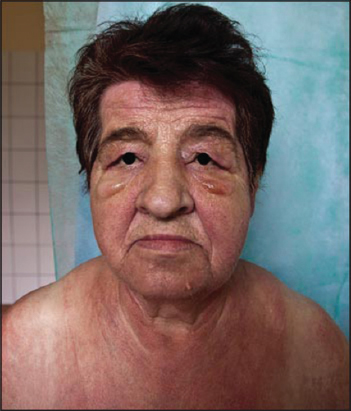 |
Figure 1: V- sign. |
A slight cutaneous reaction to vaccination in a person partially immune to small pox [3].
VAGABOND’S SIGN
1. Parasitic melanoderma; discoloration of the skin in persons of filthy habits, caused by the irritation of lice [4]. Also called Greenhow’s sign 2. A pigmentary process from an itching disease like prurigo and pityriasis stimulating morbus Addisonii, particularly found in vagrants and tramps. Also called Vagrant’s disease and sign.
EDWARD HEADLAM GREENHOW
English physician, 1814-1888 (Fig. 2). He studied medicine at Edinburgh and Montpelier. In 1855 he was appointed lecturer on public health at St. Thomas’s Hospital. In 1875 he delivered the Croonian lectures at the Royal College of Physicians on Addison’s disease. Greenhow wrote: 1. ‘On Diphtheria,’ 1860. 2. ‘On Addison’s Disease,’ 1866. 3. ‘On Chronic Bronchitis,’ 1869. 4. ‘Croonian Lectures on Addison’s Disease,’ 1875. He also prepared the following parliamentary reports: ‘The different Proportions of Deaths from certain Diseases in different Districts in England and Wales,’ 1858 [4,5].
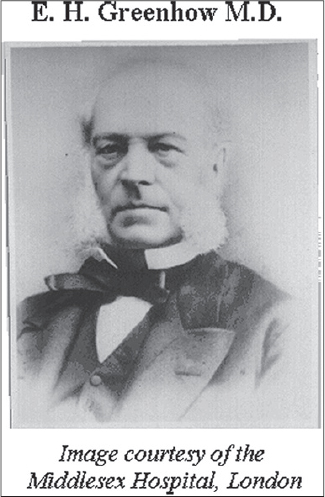 |
Figure 2: Edward Headlam Greenhow. |
Also called Vagabond’s sign.
VALLEY FEVER SIGN
Zoonotic fungal coccidioidomycosis [6].
VAMPIRE’S SIGN
Severe mutilating skin lesions caused by photosensitivity, neurological disruptions, liver pathology, and strange purple urine. These are indications of forms of porphyria. It is now suggested that Vlad Dracul the I5,h century slayer prince, also known as Vlad the Impaler suffered from hereditary porphyria. There is supporting evidence that some sufferers craved blood due to iron deficiency. Coupled with the fact that the disease can he manifested with painful cutaneous photosensitivity, allowing some victims to only come out after dark caused them to be sadly mistaken for yampires. Also called Dracula’s sign [7].
VLAD DRACUL
Vlad III the Impaler. Prince of Wallachia, dynasty of Basarab. (1431–1476) (Fig. 3). It’s best known for his resistance against the Ottoman Empire and its expansion. His postmortem moniker of “Impaler” originated in his killing opponents by impalement. In Turkish, he was known as “Kazikli Voyvoda” which means “Impaler Prince”. Was born in Sighisoara, Transylvania (part of the Kingdom of Hungary at the time).
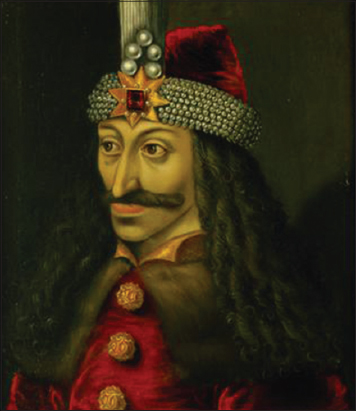 |
Figure 3: Vlad Dracul. |
Free flow of saliva, bluish or greenish vomited material, strong coppery taste. A sign of poisoning with copper salts [8]. Also known as Salivation sign.
VERONAL SIGN
Lips and finger-tips blue, drooping of eyelids, and usually loss of control of bladder and bowels. An indication of barbitonum poisoning [9]. Also known as Barbitonum sign.
VINCENT’S SIGN
A pupil which is miotic and responds to accommodation effort, however it does not respond to light [10–12]. Also known as Argyll Robertson’s sign or pupil.
DOUGLAS MORAY COOPER LAMB ARGYLL ROBERTSON
Scotch ophthalmologist and surgeon, 1837-1909 (Fig. 4). After earning his degree in 1857 from the University of St Andrews, he went to Berlin to study under Albrecht von Graefe. Robertson spent most of his medical career in Edinburgh as an eye surgeon at the Edinburgh Royal Infirmary and teacher of ophthalmology at the University of Edinburgh. For a while he was honorary eye physician to Queen Victoria and King Edward VII. Robertson made several contributions in the field of ophthalmology; in 1863 he researched the effects on the eye made by physostigmine, an extract from the Calabar bean (Physostigma venenosum), which is found in tropical Africa. He correctly predicted that physostigmine would become very important in the treatment of eye disorders. He also described a symptom of neurosyphilis that affects the pupils of the eye, which is known today as Argyll Robertson pupils [10,11].
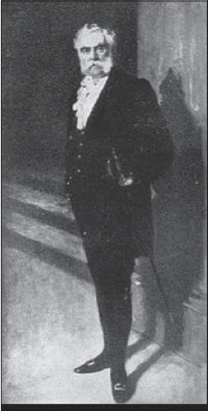 |
Figure 4: Douglas Moray Cooper Lamb Argyll Robertson. |
French physician, 1862-1950. His name is associated with Vincent’s Disease or Vincent s Angina. It is also widely known as Trench Mouth, due to an outbreak in soldiers in trenches during World War One. Borrelia vincentii used to be spread out worldwide, but is now mainly in countries that are not very developed [10,11].
VINCENT’S WAR SIGN
Painful, acute necrotizing ulcerative gingivitis [10–15]. Also known as ulceromembranous gingivitis, and Trench Mouth sign or ANUG sign.
VIOLET SWEAT SIGN
Chromidrosis, perspiration with a violet color. Similar sign: Lusitanus’s sign [13], Chojnowski’s sign [16], Bartholinus’s sign [17].
VOLCANO SIGN
It is descriptive term for the morphologic feature of Old World cutaneous leishmaniasis (Fig. 6) [18–20]. The lesion starts as a small nontender papule, which enlarges in size and ulcerates in the centre. The border of the crusted ulcer often has an erythematous rim and is called as “Volcano sign”. Also known as oriental boil, cutaneous leishmaniasis, Delhi boil, old world leishmaniasis, oriental sore, tropical sore, oriental boil, Bagdad boil, Delhi sore, Bombay boil, deli fever, Biskra button, furunculus Orientalis, Jericho boil, Tashkent ulcer, herpes du nil, die Orientbeule, die Aleppobeule, orientbyld, pendsjabzweer, lupus endemicus, leishmaniasis furunculosa, Bombaybuil, Bassorabuil, Cochinzweer, Bagdadbuil, Asjbadkazweer, leishmaniasis tropica, Aleppobuil, bouton du Nil, φ?μα της Ανατολ?ς, fuma tis anatolis, (Saunders 1945, E.J. Marzinowsky and Bogbow 1904).
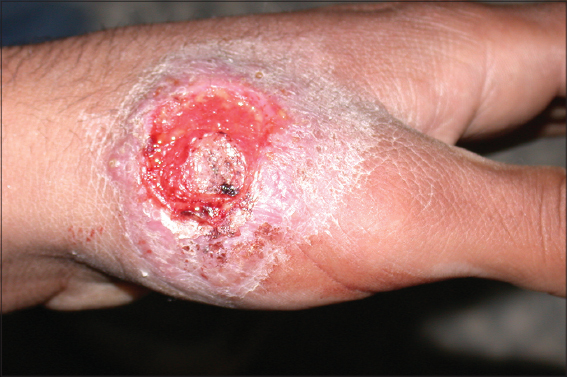 |
Figure 6: Volcano sign. |
REFERENCES
1. Stawczyk-Macieja M, Szczerkowska-Dobosz A, Błażewicz I, Wilkowska A, Nowicki R. Dermatomyositis related to the relapse of cervical cancer. Our Dermatol Online. 2015;6:183-6.
2. Famularo G. Amyopathic dermatomyositis associated with an endometrial adenocarcinoma. Our Dermatol Online. 2017;8:235-6.
3. Docekal JW, Francisco G, Lee JC. Recurrent epicardial ventricular tachycardia following smallpox vaccination. HeartRhythm Case Rep. 2018;5:6-9.
4. Brzezinski P, Sinjab AT, Masferrer E, Gopie P, Naraysingh V, Yamamoto T, et al. Dermatology Eponyms –sign –Lexicon (G). Our Dermatol Online 2012;3:243-57.
5. Greenhow EH. On Addison`s Disease:Clnical Lectures and Reports on Diseases of the Supra-renal Capsules [with Comments on Dr. Addison`s Treatment and Theory]. London, J. W. Roche, 1866. On Addison`s Disease, being the Croonian Lectures for 1875.
6. Deresinski S, Mirels LF. Coccidioidomycosis:What a long strange trip it’s been. Med Mycol. 2019;57(Supplement_1):S3-S15.
7. Brzezinski P, Wollina U, Poklękowska K, Khamesipour A, Herrero GJE, Bimbi C, et al. Dermatology eponyms –phenomen/sign –Lexicon (D). N Dermatol Online. 2011;2:158-70.
8. Krízek M, Senft V, Motán J. [Copper and the human body]. Cas Lek Cesk. 1997;136:698-701.
9. Rodichok LD. A case of barbiturate poisoning with a readily-accessible laboratory reagent. J Toxicol Clin Toxicol. 1992;30:455-8.
10. Brzeziński P, Sinjab AT, Campbell CM, Kentorp N, Sand C, Karwan K. Dermatology Eponyms –phenomen/sign –Lexicon (supplement). Our Dermatol Online. 2012;3:147-55.
11. Brzezinski P, Hassan I, Chiriac A, Sinjab AT. Dermatology Eponyms –sign –Lexicon (I). Our Dermatol Online. 2013;4:256-9.
12. Brzezinski P, Pessoa L, Galvão V, Barja Lopez JM, Adaskevich UP, Niamba PA, et al. Dermatology Eponyms –sign –Lexicon (H). Our Dermatol Online. 2013;4:130-43.
13. Brzezinski P, Chiriac A, Rath SK. Dermatology Eponyms –Sign –Lexicon –(M). Our Dermatol Online. 2014;5:442-7.
14. Brzezinski P, Chiriac A, Arenas R, Dori GU, Monteiro R, CairncrossS, et al. Dermatology Eponyms –Sign –Lexicon –(L). Our Dermatol Online. 2014;5:217-30.
15. Brzeziński P, Martini L, Di Martino Ortiz BA, Sajjan V, Narita M, Ono Y, et al. Dermatology Eponyms –sign –Lexicon (T). Part 2. Our Dermatol Online. 2019;10(2):X-X.
16. Brzeziński P, Passarini B, Nogueira A. Dermatology eponyms –phenomen/sign –dictionary (C). N Dermatol Online. 2011;2:81-100.
17. Brzeziński P, Hossein S-Z, Shane T, Bonifaz A, Arenas R, Royer-Bégyn M. Dermatology eponym –phenomen/sign –Dictionary (B). N Dermatol Online. 2011;2:35-45.
18. Kubba R, Al-Gindan Y, el-Hassan AM, Omer AH. Clinical diagnosis of cutaneous leishmaniasis (oriental sore). J Am Acad Dermatol. 1987;16:1183-9.
19. Brzeziński P, Wass J, White K, Daboul MW, Arlt W, van den Hombergh P, et al. Dermatology eponyms –phenomen/sign –Dictionary (A) –continued. N Dermatol Online. 2011;2:27-34.
20. Salissou L, Doulla M, Ouedraogo MM, Brah S, Daou M, Ali D, Adehossi E. [A crushing ulcerous lesion of the internal angle of the right eye:Cutaneous leishmaniasis is one of the causes]. Our Dermatol Online. 2018;9:203-6.
Notes
Source of Support: Nil
Conflict of Interest: None declared.
Request permissions
If you wish to reuse any or all of this article please use the e-mail (brzezoo77@yahoo.com) to contact with publisher.
| Related Articles | Search Authors in |
|
 http://orcid.org/0000-0001-6817-606X http://orcid.org/0000-0001-6817-606X |
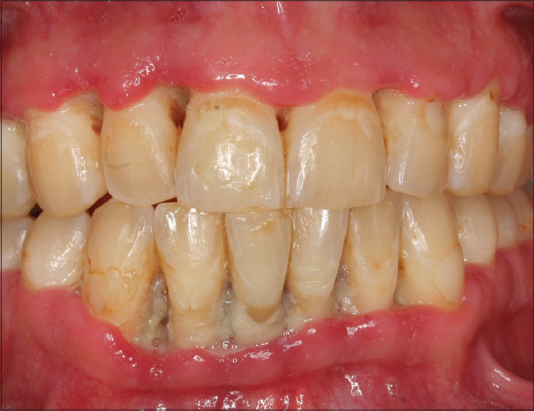


Comments are closed.